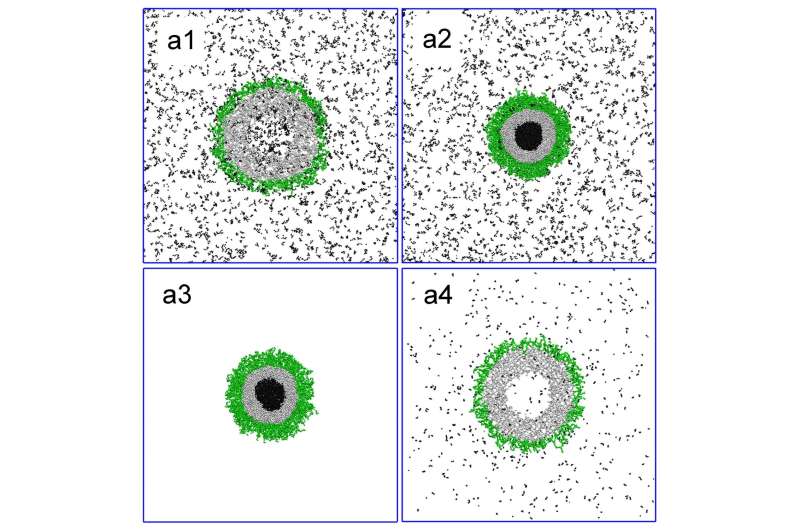Unique nano-capsules promise the targeted drug delivery

Scientists have been engaged with drug delivery systems for a long time. Many "nano-carriages" for drug delivery to the desired location have been created, but many challenges remain, including preventing the medicine from acting before delivery to the right place in a body.
"Many existing carriers encapsulate drugs through the long-range electrostatic interactions—the carrier attracts oppositely charged medicine. Our method does not deal with the electrostatics at all. Filling in the nanogel by the guest molecules, locking them in the cavity and further release are controlled by the temperature. Therefore, the medicines themselves can be both charged and neutral," says one of the Russian co-authors of the article, Professor Igor Potemkin.
According to the authors, there are other methods to trigger the release of drugs, for example, using an external magnetic field. But in each case, researchers confront the problem of efficiency of the drug release.
The scientists tested the gel nano-capsules, which were previously undervalued as carrier systems. Their main problem is that the capsules stuck together with their neighbors (lost colloidal stability) during drug delivery. Such behavior made the delivery impossible or ineffective. The scientists solved this problem by creating a carrier, the inner cavity of which is surrounded by two "membranes" of different chemical structures, like an egg with two shells.

The outer porous shell plays a protective stabilizing role and hinders the aggregation of the nano-capsules, while the pores of the inner shell can open and close depending on the temperature due to the variable interactions between its monomeric units.
During filling, the pores of both shells are open and the nanogel absorbs the drug molecules like a sponge.Then the temperature changes and the pores of the inner shell close, and locked in the cavity, the drug is ready for the delivery. Subsequently, the pores will open again and the guest molecules will be releasedonly in the places where the temperature allows.
The nanogel design was reduced to the synthesis of two nanogel shells of different chemical structures around the silica core. At the end of the synthesis, the core is chemically dissolved, leaving a cavity.
Initially, the researchers were unsure how the nano-capsule was going to behave—whether its cavity would remain stable after removal of the silicon core or if it would collapse. Additionally, they didn't know whether the size of the pore was sufficient to absorb the transported substance and to release it, or whether it was locked reliably during transportation. However, in response to the temperature changes, the pores opened and closed. During delivery, the contents of the capsules were almost completely safe, and the inner cavity's shape was not only stable; it became even larger than the initial size of the silica core.
Synthesis of the nanogel capsules and the related measurements were conducted in Europe, mainly in Germany, and Russian scientists from the Lomonosov Moscow State University, Igor Potemkin and his colleague Andrey Rudov, worked on the computer modeling that allowed researchers to study the dependence of the nano-capsules' structure on the temperature. Also, the Lomonosov Moscow State University physicists simulated a method of encapsulation and release of the transported molecules under temperature variation.
At this stage, the work is preliminary and intended primarily to demonstrate the effectiveness of the concept. Experiments were carried out in the temperature range of 32-42°C. It is slightly higher than the temperature range favorable for a human, although in the future, this range can be easily narrowed, according to Igor Potemkin.
The scientific collaboration is going to continue for another four years. "There are still many questions," the scientist says. "For example, we have observed a structure in which a cavity does not collapse as the pores are closed. Now, we need to understand why it happens, how does the density of the layers' crosslink effect, i.e., what is the minimum amount of crosslinker that does not lead to a collapse of the cavity, and so on."
Potemkin is sure that the created nano-containers are the ideal carriers for targeted drug delivery. Moreover, their synthesis is neither complex nor really expensive. Although at the current stage of research, it is difficult to determine the precise cost, the collaboration's plans already include the creation of the large-scale, commercially acceptable production of nanogels.
More information: Andreas J. Schmid et al, Multi-Shell Hollow Nanogels with Responsive Shell Permeability, Scientific Reports (2016). DOI: 10.1038/srep22736
Journal information: Scientific Reports
Provided by Lomonosov Moscow State University




















